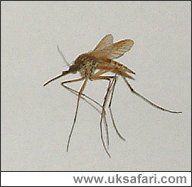
|

|
|
 Sent
to you Sent
to you
by e-mail
|
|
Simply
enter your details and hit the send button
more
info |
|


Click Here

Links
Advertise
Terms of Use
Contributors
About Us
Contact Us
|
 |
Go back
 | Bookmark
| Bookmark
 | Print Page
| Print Page  | E-Mail Us
| E-Mail Us 
 

Photo: G. Bradley |
|
UK
Safari Tip:
Try using one of our special pocket-sized magnifier boxes to get a good
close up look at mosquitoes and other insects - click
here
|
|
Latin name: Culex pipiens
Size: Approximately 8mm long
Distribution: Found throughout the UK.
Months seen: All year. Most frequently from June to October
Habitat: Always near water, including ponds, ditches and water butts.
Food: Larvae feed on tiny organic particles in the water. Adults will
feed on animal blood.
Special features: There are over thirty different species of mosquito
found in the UK, and they can easily be confused with similar non-biting
insects. The main features to look out for are the long pointed proboscis, and
the wings, which are held folded and flat when at rest. The males have bushy
antennae.
They make a high-pitched buzzing sound as they fly. The noise is
created by their wings which beat through the air around 500 times a second.
The females need a blood meal before they can lay their eggs, which is why they
bite humans. They're attracted by the carbon dioxide given off as we
breathe. They also commonly take the blood of frogs and birds.
The eggs of the mosquito are laid in still water in batches of up to 350. Each female can lay up to six batches
in one season.
 The larvae are aquatic,
and float just below the surface of the water, allowing their breathing tube to
draw in oxygen. The larvae are aquatic,
and float just below the surface of the water, allowing their breathing tube to
draw in oxygen.
There are two main groups of mosquitoes; the Anophelines, and the Culicines. The larvae of Anophelines float horizontally
just under the surface of the water, while the larvae of Culicines hang
vertically just below the surface.
 After
about seven to ten days the larvae pupate into little comma-shaped creatures.
They hang tail down below the surface of the water and breathe through two tubes
on the top of the thorax. After about five days the adult mosquito emerges. After
about seven to ten days the larvae pupate into little comma-shaped creatures.
They hang tail down below the surface of the water and breathe through two tubes
on the top of the thorax. After about five days the adult mosquito emerges.
Did you Know?
The mosquito is the most dangerous animal on the planet to mankind. It is
responsible for killing millions of people each year, and has
killed around half of all the humans who have ever lived. In warmer countries
mosquitoes can
transmit malaria, parasitic worms, yellow fever and other diseases.

UK Safari Creepy-Crawlies Section
|
 |

|